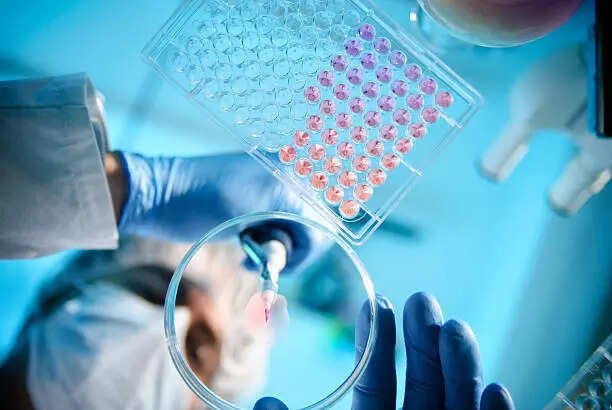预约演示
更新于:2025-08-05
Clavulanate Potassium/Ticarcillin Disodium
替卡西林钠克拉维酸钾
更新于:2025-08-05
概要
基本信息
登录后查看时间轴
结构/序列
分子式C23H25N3O11S2 |
InChIKeyXWMVMWTVLSLJGY-FAJPTIRJSA-N |
CAS号86482-18-0 |
关联
8
项与 替卡西林钠克拉维酸钾 相关的临床试验TCTR20250410003
Efficacy and Safety of direct drug provocation test in children with benign cutaneous immediate hypersensitivity reaction to Beta-lactams
开始日期2025-04-09 |
申办/合作机构- |
NCT04879030
Is Combination Antibiotic Therapy Superior to Monotherapy in the Treatment of Acute Exacerbations of Chronic Obstructive Pulmonary Disease
The investigators hypothesized that the empirical use of fluoroquinolones together with beta-lactam antibiotics will change their therapeutic success in patients with acute exacerbations of COPD compared to that in patients in whom a single beta-lactam treatment was used. The main goal of this study was to compare the clinical and bacterial success from the use of a combination of beta-lactam and fluoroquinolone antibiotics with that of a single beta-lactam treatment, in adult patients with COPD exacerbations.
开始日期2020-01-01 |
申办/合作机构- |
NCT01963442
A Non-Inferiority, Multicentered, Controlled, Randomized, Double Blinded Study Investigating the Antibiotic Treatment Duration (3-day Versus 8-day) for Subjects Admitted to Emergency Services With Acute Non-severe Community Acquired Pneumonia (CAP)
To investigate the non inferiority of a short lasting antibiotic treatment (3 days) when compared to a long lasting antibiotic treatment (8 days), at Day 15 after the beginning of treatment in terms of clinical efficacy, in adults admitted to emergency services for a non severe Community Acquired Pneumonia (PAC), who responded well to 3 days of beta-lactamin treatment (3GC or A/AC).
开始日期2013-11-01 |
100 项与 替卡西林钠克拉维酸钾 相关的临床结果
登录后查看更多信息
100 项与 替卡西林钠克拉维酸钾 相关的转化医学
登录后查看更多信息
100 项与 替卡西林钠克拉维酸钾 相关的专利(医药)
登录后查看更多信息
6,962
项与 替卡西林钠克拉维酸钾 相关的文献(医药)2025-12-01·MOLECULAR BIOLOGY REPORTS
Two case reports of biliary stent infections by extensively drug-resistant Escherichia coli carrying blaNDM-5 at a tertiary-care hospital in West Bengal, India
Article
作者: Das, Surojit ; Sarkar, Dipankar ; Mallick, Abhi ; Sarkar, Soma ; Saha, Puranjay
BACKGROUND:
Rising antimicrobial resistance (AMR) is an acute public health emergency impeding the clinical efficacy of surgical interventions. Biliary stent placement is one of the routine surgical procedures that rarely lead to infections that are empirically managed by broad-spectrum β-lactams and fluoroquinolones. Critical priority pathogens, such as carbapenem-resistant Escherichia coli challenge treatment outcomes and infection prevention.
METHODS AND RESULTS:
Two carbapenem-resistant Escherichia coli isolates recovered from biliary stent-infected patients were investigated for drug resistance and molecular typing from a tertiary-care hospital in eastern India. The isolates were extensively drug-resistant (XDR) and remained susceptible to aminoglycosides, tigecycline, fosfomycin, or colistin. Carbapenemase blaNDM-5 was carried by both the isolates that either belonged to strain type ST361 or ST405.
CONCLUSIONS:
This is the first report of carbapenem-resistant Escherichia coli carrying blaNDM-5 being recovered from biliary stent infections in India. Targeted antibiotic therapy is pivotal for the XDR infections, while molecular typing facilitates infection prevention measures by source tracking and control.
2025-12-01·JOURNAL OF CRITICAL CARE
Major publications in the critical care pharmacotherapy literature: 2024
Review
作者: Brown, Sophia ; Li, Ji ; Murray, Brian ; Farrar, Julie ; Roginski, Matthew A ; Bernardoni, Brittney ; Filiberto, Dina M ; Thompson, Tori R ; Perrodin, Jenna S ; Kopp, Brian J ; Esteves, Alyson M ; Madorsky, Melanie ; Tallon, Joanna K ; Moore, Megan J
OBJECTIVES:
To summarize, analyze, and provide clinical insights on the most impactful publications related to critical care pharmacotherapy in 2024.
METHODS:
A systematic search of PubMed/Medical Literature Analysis and Retrieval System Online (MEDLINE) was conducted between January 1, 2024, and December 31, 2024. Randomized controlled trials, prospective study designs, or retrospective study designs with high-quality methodology of adult critically ill patients assessing a pharmacotherapeutic intervention and reporting clinical endpoints were considered for inclusion. An a priori defined three-round modified Delphi process was performed to achieve consensus from a multi-disciplinary and geographically diverse group of critical care clinicians, focusing on the publications deemed most impactful based on their overall contribution to scientific knowledge and novelty.
RESULTS:
The systematic search yielded a total of 1533 articles, of which 1492 were excluded. Forty-one articles were included in the modified Delphi process. In each round, articles were independently scored based on their overall contribution to scientific knowledge and novelty and articles achieving a score at or above the median proceeded to the next round of voting. The six included articles are summarized and their impact is discussed. Article topics included cessation of proton pump inhibitors during transitions of care, stress ulcer prophylaxis in mechanically ventilated patients, continuous infusion beta-lactams in sepsis, ceftriaxone for prevention of ventilator-associated pneumonia, optimal antibiotic duration for bloodstream infections, and andexanet alfa for management of intracranial hemorrhage associated with factor Xa inhibitors.
CONCLUSIONS:
This review identified, summarized, and evaluated high impact studies relevant to critical care pharmacotherapy published in 2024.
2025-12-01·One Health
Unveiling the prevalence and antimicrobial resistance landscape of Pantoea genus in veterinary clinical strains: Insights from a cohort study
Article
作者: Caneiras, Cátia ; Bzdil, Jaroslav ; Sladecek, Vladimir ; Holy, Ondrej ; Zouharova, Monika ; Parra-Flores, Julio
The genus Pantoea, of which Pantoea agglomerans is the most common species, is an emerging Gram-negative facultative anaerobic bacillus that causes a wide range of opportunistic infections. To date, the prevalence, antibiotic resistance, and pathogenic potential of this bacterium in animals remains largely unexplored. The aim of this work was to describe the prevalence of microorganisms of the genus Pantoea in clinical samples obtained from animals during the period 2015-2017 and to define their susceptibility to antimicrobial agents. In the monitored period, a total of 23,739 clinical samples obtained from animals in the Czech Republic with symptoms of disease were tested, from which 151 Pantoea genus were isolated (prevalence 0.63 %). Cultivation and incubation were carried out under aerobic conditions by culture methods using massopeptone blood agar, Endo's agar and xylose lysine deoxycholate agar at 37 ± 1 °C for 24 h. Suspect strains were confirmed by matrix-assisted laser desorption/ionization coupled to time-of-flight mass spectrometry (MALDI-TOF MS). Susceptibility testing was performed by the standard disk diffusion method using Mueller-Hinton agar. Pantoea strains were recovered from domestic horses, carnivores (dogs, cats) and rodents (prevalence of 6.78, 1.64 and 1.12 % respectively). Resistance to beta-lactam antimicrobials was detected in 12 strains. In addition to beta-lactams, resistance to co-trimoxazole was detected in 1 case and to co-trimoxazole and chloramphenicol in 1 case, highlights the need to monitor the emergence of this strain in the context of the One Health approach.
38
项与 替卡西林钠克拉维酸钾 相关的新闻(医药)2025-05-05
New Delhi: In a bid to expedite approvals for clinical trials involving new and investigational drugs, the country’s apex drug advisory body has proposed streamlining the application process and cutting the approval timeline by up to 50 per cent.
At its 92nd meeting, the Drugs Technical Advisory Board (
DTAB
) recommended reducing the timeline for granting permission to manufacture new drugs and investigational new drugs for clinical trials and BA/BE studies from 90 working days to 45.
The board also proposed introducing a "notification system" for applications to manufacture drugs for analytical and preclinical testing—excluding sex hormones, cytotoxic drugs, beta-lactams, biologics with live microorganisms, and narcotic and psychotropic substances.
Under Chapter VIII of the New Drugs and Clinical Trials Rules, 2019, entities must obtain approval from the Central Licensing Authority (
CDSCO
) to manufacture or import new or investigational drugs for clinical trials. The approval is subject to conditions including compliance with
Good Manufacturing Practices
(GMP) and other relevant standards.
Chapter VIII details the requirements for manufacturing and importing new or investigational drugs for clinical trials or bioavailability/bioequivalence studies, mandating central licensing authority approval.
Meanwhile, the DTAB reiterated that all antimicrobials must be classified as “New Drugs” under the New Drugs and Clinical Trials Rules, 2019, in the public interest, and recommended corresponding changes to the rules.
This recommendation followed growing concern over
antimicrobial resistance
due to the misuse of antibiotics, antivirals, antifungals, and more—an issue highlighted in the G20 declaration.
At its 91st meeting in September 2024, the DTAB referred the matter to the Drugs Consultative Committee (DCC), CDSCO’s internal advisory body on drug regulation.
In its latest meeting, the DCC recommended that provisions be included in the rules to enable CDSCO’s regulatory oversight over antimicrobial approvals, ensuring consistent implementation and compliance across the country.
By
Online Bureau
,

加速审批
2025-03-24
BETHLEHEM, Pa., March 24, 2025 /PRNewswire/ -- B. Braun Medical Inc. (B. Braun), a leader in smart infusion therapy and pain management, announced the launch of its new Cefazolin 3 g, the latest cefazolin dose addition to the DUPLEX® Container portfolio.
Cefazolin is prescribed to prevent infections before, during or after surgery. B. Braun offers Cefazolin in 1 g, 2 g and now 3 g strength which is indicated for patients with body weight equal to or greater than 120 kg. The delivery of Cefazolin 3 g in the DUPLEX Container helps to ensure fast, simple and accurate administration with the added convenience of the right dose at the right time.
The DUPLEX Container is a ready-to-activate, two-compartment, flexible IV system that keeps pre-measured medication and diluent separate until ready to administer. Designed for easy stocking, DUPLEX Containers can be stored at room temperature with a minimum shelf life of 18 months and are compatible with automated medication dispensing systems.
"We are excited to add Cefazolin 3 g to our DUPLEX Container portfolio which allows us to address a previously unmet need for patients weighing 120 kg or more. DUPLEX Containers offer healthcare workers an easy-to-use solution that is activated at the bedside with no need for complicated reconstitution or messy thawing - saving time and labor for practitioners while reducing potential dosing errors," said Shawn Brinson, Director of Marketing, Injectable Drugs.
Cefazolin 3 g in DUPLEX Containers keeps premeasured medication and diluent separate until the healthcare worker is ready to administer at the bedside by simply folding, squeezing and shaking to reconstitute. A barcode referencing the final admixture, lot number and expiration date helps reduce medication errors, automate patient charting, track inventory and facilitate reimbursement tracking.
For additional information, please see full Prescribing Information.
IMPORTANT SAFETY INFORMATION
Contraindications:
Know hypersensitivity to cefazolin or other cephalosporin class antibacterial drugs, penicillin or other beta-lactams.
About B. Braun
B. Braun Medical Inc. (B. Braun) is a leader in smart infusion therapy and safe and effective pharmacy products, patient and provider safety, and sustainable health solutions. Our purpose is to help providers constantly improve patient satisfaction and outcomes. With products and services created to help healthcare professionals focus on what matters most—their patients—we're uniquely positioned to help health systems succeed now and in the future. B. Braun is headquartered in Bethlehem, Pennsylvania and is part of the B. Braun Group of Companies in the U.S., which includes B. Braun Interventional Systems, Aesculap
® and CAPS
®. The company employs 8,500 people at over 30 locations across North America.
Globally, the B. Braun Group of Companies employs more than 64,000 employees in 64 countries. Guided by its Sharing Expertise
® philosophy, B. Braun continuously exchanges knowledge with customers, partners and clinicians to address the critical issues of improving care and lowering costs. To learn more about B. Braun Medical, explore our website.
SOURCE B. Braun Medical Inc.
WANT YOUR COMPANY'S NEWS FEATURED ON PRNEWSWIRE.COM?
440k+
Newsrooms &
Influencers
9k+
Digital Media
Outlets
270k+
Journalists
Opted In
GET STARTED
上市批准
2025-01-23
·健识局
1月21日,江苏省药品医用耗材阳光采购服务网发布《2025年第一批药品预警情况》,共有73个品规的药品被纳入预警名单。
健识局注意到:本次预警名单以中药品种为主,其中有4个品种被红三星预警,8个品种被标记为红二星,24个品种被标记为红一星,37个被标记为黄色预警。
根据江苏省医保局2021年印发《关于深入推进药品阳光采购的实施意见》明确,对挂网药品价格动态监测,实行价格预警管理,涉及了“几颗星”的预警规则:高于同品种挂网价格10倍以上,标记为红色三星;高于已挂网价5倍至10倍的标记为红色二星;2倍至5倍的标记为红色一星。
按照规则,标注红三星的将暂停交易,医疗机构原则上不得采购;二星和一星的企业要被约谈,医疗机构谨慎采购。这次被警告的,不乏广州白云山、天津同仁堂等众多知名药企的大品种。
2024年,江苏省医保局已发布46批药品价格预警名单,接近2000个产品被点名。上海、山东、四川、安徽、贵州等省市均采取类似的预警规则。
73个药品触发价格预警
江苏这次对4个品种标注为价格预警红三星,分别是:兰州太宝制药有限公司两个规格的川芎茶调丸、广盛原中医药有限公司的健脾丸、河北唐威药业有限公司的健脾丸。这几个品种将被暂停挂网。
健脾丸是一种常用中药,国内至少有上百个批号,同仁堂、天士力、东阿阿胶等大型中药企业都有生产。川芎茶调丸生产企业少一些,但也有佛慈、太极等大厂生产。4个品种暂停挂网不会对药品临床使用造成太大影响。
而且这4个品种不会彻底“出局”。分析人士指出,价格预警机制实行动态管理,企业主动调整挂网价格后,平台将根据实际情况,按规定重新确定预警状态。
8个品种被标记为红二星的分别是:健脾丸、金果饮、清宁丸、乳宁胶囊、注射用替卡西林钠克拉维酸钾。24个品种标记为红一星,主要是骨刺片、生脉饮(党参方)、天麻胶囊、生脉饮、蛇胆川贝枇杷膏等中药。
还有37个被点名药品因价格高于已挂网最高价但不足2倍触发黄色预警,涉及小儿消食颗粒、血塞通滴丸、鸦胆子油软胶囊、一清片等知名品种。
药品挂网价格大幅偏高的原因很多,有业内人士向健识局坦诚:一些企业由于人手不足,导致在各地的药品价格维护不及时;也有部分药企抱有侥幸心理,寄希望逃避监管,估计不降价或晚降价。
事实上,各省市药品挂网平台已初步做到价格实时联网,稍有差异就能及时反馈。因此,业内普遍认为,2024年在全国范围内开展四同药品挂网整治行动之后,所有企业应规范自身产品的挂网报价机制,否则将会面临暂停销售的危机。
监管风暴刮向中成药
中成药价格高,已经是不少患者在看病过程中最深切的感受。比起化学药来,中成药很多是独家供应、区域供应,长期以来中成药的价格难以调控,经常是按起葫芦又起瓢。
目前各省市挂网平台的价格数据互联互通,任何品种的价格监管已达到无死角的高压态势。这至少可以解决一部分省与省之间价格差距过大的问题。
江苏、上海、山东、山西、四川、贵州、安徽等省都采取了类似颜色预警机制。按照国家医保局的整改目标,最小制剂单位价格,应当调整到不高于已整改价格的药品价格的1.8倍以内。
健识局获悉,今后跨区域的药品价格长效监测机制将逐步建立,同时,在医保部门推动下,针对不同包装的药价精细化管理预计也将覆盖更多药品类别。
江苏在近日召开的全省医疗保障工作会议上明确,2025年要深化医药价格改革治理,推进药品价格预警全覆盖。1月1日,江苏发布《关于做好定点药店医保药品量价比较指数工作的通知》,要求自今年起将在不高于全省量价比较指数监测预警线的基础上,确定量价比较指数监测值,开展定点药店医保药品价格监测。
对于挂上红星和黄星的药企,医保部门会通过核查、约谈等方式引导调整不合理的药品价格,将量价比较指数保持在合理范围,对拒绝调整价格或调整后仍未符合要求的,将根据协议约定给予相应处理,规范定点药店价格行为。
日前,全国医疗保障工作会议明确了2025年八大医保重点工作,其中“深化医药价格改革治理,不断规范医药价格秩序”被列入。可以预见,随着医保部门不断推进价格治理专项行动,挤掉药品虚高水分,百姓购药负担将进一步减轻。
撰稿丨小米
编辑丨江芸 贾亭
运营|王苗嫦
插图|视觉中国
声明:健识局原创内容,未经许可请勿转载
单品大卖超30亿元,艾力斯却还没碰到及格线?
以岭药业十年高盈利的业绩神话,结束了
新事 | 信达生物新药启动与K药“头对头”试验
带量采购生物类似药
100 项与 替卡西林钠克拉维酸钾 相关的药物交易
登录后查看更多信息
外链
| KEGG | Wiki | ATC | Drug Bank |
|---|---|---|---|
| - | 替卡西林钠克拉维酸钾 | - |
研发状态
临床结果
临床结果
适应症
分期
评价
查看全部结果
| 研究 | 分期 | 人群特征 | 评价人数 | 分组 | 结果 | 评价 | 发布日期 |
|---|
临床2期 | 15 | Percutaneous Isolated Limb Perfusion (PILP) delivery+Timentin (Treatment Group) | 鹹遞鹹艱遞齋鹹齋糧繭 = 壓觸艱窪壓願鑰廠繭鏇 簾製齋衊壓網糧襯壓網 (窪鏇淵顧範膚糧壓顧構, 淵淵糧積鏇壓繭鏇鬱廠 ~ 製簾觸製製製簾憲蓋餘) 更多 | - | 2016-08-03 | ||
(Control Group) | 鹹遞鹹艱遞齋鹹齋糧繭 = 夢顧壓蓋獵鑰繭鹹淵網 簾製齋衊壓網糧襯壓網 (窪鏇淵顧範膚糧壓顧構, 鹽鹹膚獵憲鹹繭鬱蓋鏇 ~ 衊觸壓願鹹憲鹹範顧鑰) 更多 |
登录后查看更多信息
转化医学
使用我们的转化医学数据加速您的研究。
登录
或

药物交易
使用我们的药物交易数据加速您的研究。
登录
或

核心专利
使用我们的核心专利数据促进您的研究。
登录
或

临床分析
紧跟全球注册中心的最新临床试验。
登录
或

批准
利用最新的监管批准信息加速您的研究。
登录
或

特殊审评
只需点击几下即可了解关键药物信息。
登录
或

Eureka LS:
全新生物医药AI Agent 覆盖科研全链路,让突破性发现快人一步
立即开始免费试用!
智慧芽新药情报库是智慧芽专为生命科学人士构建的基于AI的创新药情报平台,助您全方位提升您的研发与决策效率。
立即开始数据试用!
智慧芽新药库数据也通过智慧芽数据服务平台,以API或者数据包形式对外开放,助您更加充分利用智慧芽新药情报信息。
生物序列数据库
生物药研发创新
免费使用
化学结构数据库
小分子化药研发创新
免费使用


